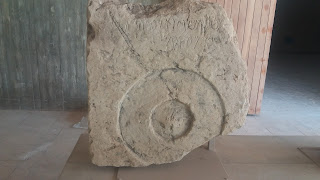dedicated by Lucius Annius Maton.This stone inscription, discovered in Volubilis, a Roman city in Morocco

The inscription reads: Imp(eratori) Caes(ari) Aug(usto) / divo Antonino Pio / L(ucius) Annius Matun / Anni Honorati lib(ertus) / ob honor(em) IIIIIIvir(atus) / p(osuit) d(edicavitque) This stone inscription, discovered in Volubilis, a Roman city in Morocco, was created and dedicated by Lucius Annius Maton, a Roman official who served as a prefect and local magistrate overseeing religious and public affairs in the city. The inscription reflects Lucius Annius Maton's gratitude and loyalty to his patron and benefactor Annius Honoratus, who aided his ascent from slavery to a prominent position. Annius Honoratus served as the editor of Emperor Antoninus Pius, who ruled from 138 to 161 AD. Antoninus Pius was renowned for his peaceful and prosperous reign, and his adoption of Marcus Aurelius and Lucius Verus. The inscription, which reads "Imp(eratori) Caes(ari) Aug(usto) / divo Antonino Pio / L(ucius) Annius Matun / Anni Honorati lib(ertus) / ob honor(em) IIIIIIvir(atus) / p(osuit) d...

.jpg)



